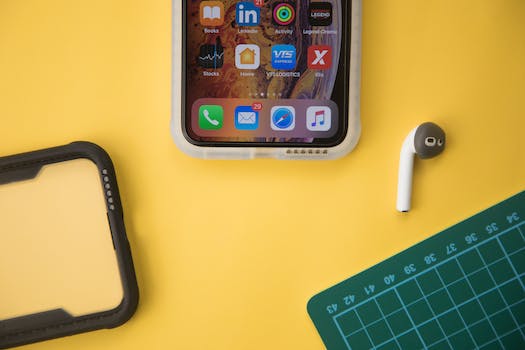

-
Table of Contents
"Harmony in a Digital World: Discovering Balance Amidst the Chaos"
Introduction
In today's fast-paced and technology-driven world, finding balance in the digital age has become increasingly important. With the constant presence of smartphones, social media, and other digital distractions, it can be challenging to maintain a healthy equilibrium between our online and offline lives. However, striking a balance is crucial for our overall well-being and productivity. This article explores the significance of finding balance in the digital age and provides insights into how we can achieve it.
The Importance of Setting Boundaries with Technology
In today's digital age, technology has become an integral part of our lives. From smartphones to laptops, we are constantly connected to the digital world. While technology has undoubtedly brought numerous benefits, it has also created challenges when it comes to finding balance in our lives. One of the key aspects of achieving this balance is setting boundaries with technology.
Setting boundaries with technology is crucial because it helps us maintain a healthy relationship with our devices. Without clear boundaries, it is easy to become consumed by technology, leading to negative consequences for our mental and physical well-being. By establishing limits on our technology use, we can ensure that we have time for other important aspects of our lives, such as spending quality time with loved ones, pursuing hobbies, and taking care of our physical health.
One way to set boundaries with technology is by establishing designated technology-free zones or times. For example, you could designate certain areas of your home, such as the dining room or bedroom, as technology-free zones. This means that when you are in these areas, you are not allowed to use your devices. Similarly, you could set specific times during the day when you will not use technology, such as during meals or before bedtime. By creating these boundaries, you can create space for meaningful interactions and relaxation without the constant distraction of technology.
Another important aspect of setting boundaries with technology is managing notifications and alerts. The constant barrage of notifications from emails, social media, and messaging apps can be overwhelming and disruptive. To avoid being constantly pulled into the digital world, consider turning off non-essential notifications or setting specific times to check and respond to messages. This way, you can regain control over your attention and focus on the tasks or activities that are most important to you.
Additionally, it is essential to establish boundaries around work-related technology use. With the rise of remote work and the blurring of boundaries between work and personal life, it is easy to find ourselves constantly checking emails or working outside of regular hours. To prevent burnout and maintain a healthy work-life balance, it is crucial to set clear boundaries around when and where you will engage in work-related tasks. This might involve establishing specific work hours, creating a designated workspace, or setting limits on the amount of time you spend on work-related activities outside of those hours.
Setting boundaries with technology also means being mindful of our digital consumption. It is easy to get caught up in mindless scrolling through social media or binge-watching shows on streaming platforms. While these activities can be enjoyable in moderation, excessive digital consumption can lead to feelings of dissatisfaction and a lack of productivity. By setting limits on the amount of time you spend on these activities and being intentional about how you use technology, you can ensure that you are using your time in a way that aligns with your values and goals.
In conclusion, finding balance in the digital age requires setting boundaries with technology. By establishing limits on our technology use, managing notifications, setting boundaries around work-related technology use, and being mindful of our digital consumption, we can create a healthier relationship with technology and regain control over our lives. Setting boundaries with technology is not about completely disconnecting from the digital world but rather about finding a balance that allows us to fully engage with both the digital and physical aspects of our lives.
Strategies for Managing Screen Time and Prioritizing Offline Activities

In today's digital age, it can be challenging to find a balance between our online and offline lives. With the constant presence of smartphones, tablets, and computers, it's easy to get caught up in the virtual world and neglect our real-life experiences. However, it's essential to prioritize offline activities and manage our screen time effectively to maintain a healthy and fulfilling lifestyle.
One strategy for managing screen time is to set specific limits and boundaries. It's crucial to establish designated times for using electronic devices and stick to them. For example, you could decide to only use your smartphone for one hour in the morning and one hour in the evening. By setting these limits, you can ensure that you have enough time for other activities and prevent excessive screen time from taking over your life.
Another helpful strategy is to create a schedule that includes both online and offline activities. By planning your day in advance, you can allocate time for work, leisure, and personal growth. This schedule should include activities such as exercise, hobbies, spending time with loved ones, and pursuing personal interests. By incorporating these offline activities into your daily routine, you can ensure that you have a well-rounded and balanced lifestyle.
It's also essential to prioritize offline activities over online ones. While the internet offers a wealth of information and entertainment, it's crucial not to let it consume all of your time. Instead, make a conscious effort to engage in activities that don't involve screens. This could include reading a book, going for a walk, practicing a musical instrument, or participating in a sport. By prioritizing these offline activities, you can enhance your overall well-being and reduce the negative effects of excessive screen time.
Additionally, it's important to be mindful of the quality of your screen time. Not all online activities are created equal, and some can be more beneficial than others. For example, spending time on social media or playing mindless video games may not contribute much to your personal growth or well-being. On the other hand, engaging in educational or creative activities online can be both enjoyable and enriching. By being selective about the content you consume and participate in online, you can make your screen time more meaningful and valuable.
Lastly, it's crucial to be aware of the impact of excessive screen time on your mental and physical health. Spending too much time in front of screens can lead to issues such as eye strain, poor posture, sleep disturbances, and decreased social interaction. It's essential to take regular breaks from screens, practice good ergonomics, and engage in activities that promote physical and mental well-being. By prioritizing your health and well-being, you can find a better balance between your online and offline lives.
In conclusion, finding balance in the digital age is essential for maintaining a healthy and fulfilling lifestyle. By implementing strategies such as setting limits, creating a schedule, prioritizing offline activities, being mindful of the quality of screen time, and prioritizing health, you can effectively manage your screen time and find a better balance between your online and offline lives. Remember, it's not about completely eliminating screens from your life but rather finding a healthy and sustainable balance that allows you to enjoy the benefits of technology while still engaging in meaningful offline activities.
Tips for Cultivating Mindfulness and Well-being in a Digitally Connected World
In today's digitally connected world, finding balance and cultivating mindfulness and well-being can be a challenge. With constant access to technology and the ever-increasing demands of work and personal life, it's easy to feel overwhelmed and disconnected from ourselves and those around us. However, with some simple tips and practices, it is possible to find balance and create a sense of well-being in the digital age.
One of the first steps in cultivating mindfulness and well-being is to establish boundaries with technology. It's important to set limits on the amount of time spent on devices and to create designated "tech-free" zones or times in your day. This can help create space for reflection, relaxation, and connection with others. By consciously choosing when and how to engage with technology, you can regain control over your time and attention.
Another important aspect of finding balance in the digital age is to prioritize self-care. Taking care of your physical, mental, and emotional well-being is crucial for overall health and happiness. This can include activities such as exercise, meditation, spending time in nature, or engaging in hobbies and interests that bring you joy. By making self-care a priority, you can recharge and rejuvenate, allowing you to better navigate the demands of the digital world.
In addition to setting boundaries and prioritizing self-care, practicing mindfulness can greatly enhance well-being in the digital age. Mindfulness involves paying attention to the present moment with curiosity and non-judgment. It can help you become more aware of your thoughts, emotions, and physical sensations, allowing you to respond to them in a more intentional and compassionate way. Mindfulness can be practiced through formal meditation, but it can also be integrated into everyday activities such as eating, walking, or even checking emails. By bringing mindfulness into your daily life, you can cultivate a greater sense of presence and connection.
Another helpful tip for finding balance in the digital age is to foster meaningful connections with others. While technology can provide opportunities for connection, it's important to also prioritize face-to-face interactions and deep, meaningful conversations. This can involve scheduling regular social activities, joining clubs or groups with shared interests, or simply making an effort to reach out to loved ones. By nurturing these connections, you can create a sense of belonging and support that can help counteract the potential isolation and disconnection that can come with excessive technology use.
Lastly, it's important to remember that finding balance in the digital age is an ongoing process. It's normal to have moments of imbalance or to feel overwhelmed by the demands of technology. However, by regularly practicing the tips mentioned above and being mindful of your own needs and limits, you can gradually create a healthier relationship with technology and cultivate a greater sense of well-being in the digital age.
In conclusion, finding balance in the digital age is possible with some simple tips and practices. By setting boundaries with technology, prioritizing self-care, practicing mindfulness, fostering meaningful connections, and being mindful of your own needs, you can navigate the demands of the digital world while cultivating a greater sense of well-being and connection with yourself and those around you. So, take a moment to reflect on your own relationship with technology and consider implementing some of these tips to find balance in the digital age.
Q&A
1. How can individuals find balance in the digital age?
By setting boundaries and limits on screen time, practicing mindfulness and self-care, and prioritizing offline activities and relationships.
2. What are the potential consequences of not finding balance in the digital age?
Potential consequences include increased stress and anxiety, decreased productivity, strained relationships, and negative impacts on physical and mental health.
3. What strategies can be helpful in achieving balance in the digital age?
Strategies such as creating a schedule for technology use, engaging in regular physical activity, practicing digital detoxes, and seeking support from friends and family can be helpful in achieving balance.
Conclusion
In conclusion, finding balance in the digital age is crucial for maintaining overall well-being and productivity. It is important to establish healthy boundaries with technology, such as setting limits on screen time and prioritizing offline activities. Additionally, practicing mindfulness and self-care can help individuals navigate the digital world more effectively and reduce the negative impacts of excessive technology use. Striking a balance between the benefits and drawbacks of the digital age is essential for leading a fulfilling and balanced life.












